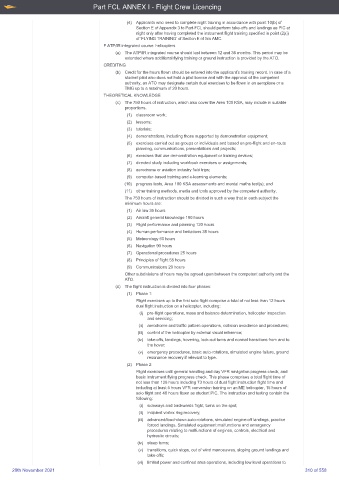Page 310 - UK Aircrew Regulations (Consolidated) 201121
P. 310
Part FCL ANNEX I - Flight Crew Licencing
(4) Applicants who need to complete night training in accordance with point 10(b) of
Section E of Appendix 3 to Part-FCL should perform take-offs and landings as PIC at
night only after having completed the instrument flight training specified in point (2)(i)
of ‘FLYING TRAINING’ of Section E of this AMC.
F ATP/IR integrated course: helicopters
(a) The ATP/IR integrated course should last between 12 and 36 months. This period may be
extended where additional flying training or ground instruction is provided by the ATO.
CREDITING
(b) Credit for the hours flown should be entered into the applicant’s training record. In case of a
student pilot who does not hold a pilot licence and with the approval of the competent
authority, an ATO may designate certain dual exercises to be flown in an aeroplane or a
TMG up to a maximum of 20 hours.
THEORETICAL KNOWLEDGE
(c) The 750 hours of instruction, which also cover the Area 100 KSA, may include in suitable
proportions.
(1) classroom work;
(2) lessons;
(3) tutorials;
(4) demonstrations, including those supported by demonstration equipment;
(5) exercises carried out as groups or individuals and based on pre-flight and en-route
planning, communications, presentations and projects;
(6) exercises that use demonstration equipment or training devices;
(7) directed study including workbook exercises or assignments;
(8) aerodrome or aviation industry field trips;
(9) computer-based training and e-learning elements;
(10) progress tests, Area 100 KSA assessments and mental maths test(s); and
(11) other training methods, media and tools approved by the competent authority.
The 750 hours of instruction should be divided in such a way that in each subject the
minimum hours are:
(1) Air law 35 hours
(2) Aircraft general knowledge 100 hours
(3) Flight performance and planning 120 hours
(4) Human performance and limitations 35 hours
(5) Meteorology 60 hours
(6) Navigation 90 hours
(7) Operational procedures 25 hours
(8) Principles of flight 55 hours
(9) Communications 20 hours
Other subdivisions of hours may be agreed upon between the competent authority and the
ATO.
(d) The flight instruction is divided into four phases:
(1) Phase 1:
Flight exercises up to the first solo flight comprise a total of not less than 12 hours
dual flight instruction on a helicopter, including:
(i) pre-flight operations, mass and balance determination, helicopter inspection
and servicing;
(ii) aerodrome and traffic pattern operations, collision avoidance and procedures;
(iii) control of the helicopter by external visual reference;
(iv) take-offs, landings, hovering, look-out turns and normal transitions from and to
the hover;
(v) emergency procedures, basic auto-rotations, simulated engine failure, ground
resonance recovery if relevant to type.
(2) Phase 2:
Flight exercises until general handling and day VFR navigation progress check, and
basic instrument flying progress check. This phase comprises a total flight time of
not less than 128 hours including 73 hours of dual flight instruction flight time and
including at least 5 hours VFR conversion training on an ME helicopter, 15 hours of
solo flight and 40 hours flown as student PIC. The instruction and testing contain the
following:
(i) sideways and backwards flight, turns on the spot;
(ii) incipient vortex ring recovery;
(iii) advanced/touchdown auto-rotations, simulated engine-off landings, practice
forced landings. Simulated equipment malfunctions and emergency
procedures relating to malfunctions of engines, controls, electrical and
hydraulic circuits;
(iv) steep turns;
(v) transitions, quick stops, out of wind manoeuvres, sloping ground landings and
take-offs;
(vi) limited power and confined area operations, including low level operations to
20th November 2021 310 of 558

